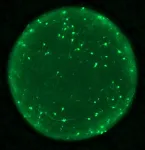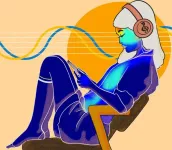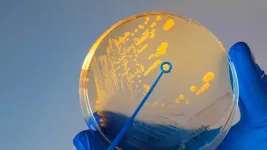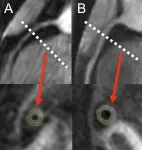(Press-News.org) Clinicians often find limited success in treating patients with traumatic brain injury, a condition long linked to contact sports and military services. A new study, published April 4 in the journal Cell Stem Cell, may offer new clues to better solutions. Scientists found a protein, TDP-43, that appears to drive nerve damage right after injury. Moreover, blocking a certain cell surface protein can correct faulty TDP-43 and curb nerve death in mouse and human cells.
“There’s really nothing out there that can prevent the injury or trauma to the brain that cause nerve cell damage,” says corresponding author Justin Ichida of the University of Southern California. “In more acute stages, patients can have difficulty concentrating and have extreme sensitivity to light and noise. Long term, there is a strong correlation between traumatic brain injury and neurodegenerative diseases, which can ultimately be fatal.”
To untangle what happens at impact, the researchers grew brain organoids—pinhead-sized, tiny clusters of human neural cells that behave like a brain. They then hit the organoids with ultrasonic pulses, mimicking severe traumatic brain injuries. Previous research has suggested that a protein called tau may underlie the nerve damage, but Ichida’s research says there’s another player.
His team found that TDP-43, which edits the genetic script that carries protein-making DNA instructions, wanders astray in injured organoids and causes nerve death. In healthy cells, TDP-43 usually resides within the nucleus, where genetic materials are located. But after injury the protein leaks out to the surrounding cytosol and cannot carry out its job.
The results showed that neurons deep in the cortex of the brain are particularly vulnerable to trauma, and genetics can affect how the disorder progresses. Organoids derived from patients with a genetic risk of neurodegenerative diseases responded to the injury more strongly with faultier TDP-43 compared to healthy ones. The findings might help explain why some individuals are at higher risk for developing these diseases after trauma.
“We then tested every gene in the human genome to see if we could rescue that injury by suppressing any individual gene,” says Ichida. The screening came back with a hit—KCNJ2, a gene that encodes the mechanosensory channel protein on cell surfaces. “If we suppressed the gene, it reversed all the problems associated with the injury and kept the nerve cells alive.”
Blocking both KCNJ2 gene activity and its protein, respectively, raised the neurons’ survival rate in organoids. The team saw similar effects in mouse models of traumatic brain injury when they targeted KCNJ2, reducing misplaced TDP-43. Treating injured organoids from patients with neurodegenerative disease risk using KCNJ2 protein blockers before injury not only reduced nerve death but also lowered the TDP-43 buildup in cells. The results suggest dampening KCNJ2 activity may protect the brain from trauma.
About 5 million Americans live with traumatic brain injury-related disabilities. With more research, Ichida can foresee new opportunities for improving prevention, diagnosis, and treatment. The findings may help inform people of their genetic risks and guide safety measures. TDP-43 may also serve as a biological marker to detect traumatic brain injury and monitor the damage one day.
“Our study suggests that one of the more effective ways of preventing the devastating effects of traumatic brain injury might be to fix TDP-43 and prevent its mislocalization early after injury,” says Ichida.
###
Please see the paper text for funding information and declarations of interest.
Cell Stem Cell, Lai et al. “KCNJ2 inhibition mitigates mechanical injury in a human brain organoid model of traumatic brain injury” https://cell.com/cell-stem-cell/fulltext/S1934-5909(24)00085-7
Cell Stem Cell (@CellStemCell), published by Cell Press, is a monthly journal that publishes research reports describing novel results of unusual significance in all areas of stem cell research. Each issue also contains a wide variety of review and analysis articles covering topics relevant to stem cell research ranging from basic biological advances to ethical, policy, and funding issues. Visit http://www.cell.com/cell-stem-cell. To receive Cell Press media alerts, contact press@cell.com.
END
Lack of respectful maternity care in the U.S. culminating in mistreatment in childbirth is a regular occurrence, according to a new study at Columbia University Mailman School of Public Health. Yet until now experiences of this mistreatment had not been widely documented in the United States. The findings are published in JAMA Network Open.
To estimate the prevalence of mistreatment by care providers in childbirth, the researchers collected survey data from a representative sample of people who had a live birth in 2020 ...
An astrophysicist from The University of Texas at Dallas and his colleagues from the Dark Energy Spectroscopic Instrument (DESI) collaboration are at the forefront of an ambitious experiment to study the expansion of the universe and its acceleration.
Dr. Mustapha Ishak-Boushaki, professor of physics in the School of Natural Sciences and Mathematics (NSM) at UT Dallas, is a member of the DESI collaboration, an international group of more than 900 researchers from over 70 institutions around the world engaged in a multiyear experiment to increase understanding of the ...
Music which surprises us can be felt in the heart, while music which matches our expectations can bring feelings of calmness and satisfaction, according to a new study. Researchers played eight short tunes made up of just four chords each to over 500 participants. Each tune had a varied mix of surprising and unsurprising, and certain and uncertain chord progressions. When asked to report how the tunes made them feel and where they were affected, participants’ answers showed that fluctuations in predictions about chord sequences were felt in specific parts of the body, notably the heart and abdomen. Researchers also ...
A nerve-stimulation treatment for obstructive sleep apnea that originally was approved only for people with body mass indexes (BMIs) in the healthy range recently was extended to patients with BMIs up to 40, a weight range generally described as severely obese. A healthy BMI ranges from 18.5 to 24.9.
The expanded eligibility criteria for the treatment provide more sleep apnea patients with access to the increasingly popular therapy, known as hypoglossal nerve stimulation. However, new research from Washington University School of Medicine in St. Louis indicates that the likelihood of successful nerve-stimulation treatment ...
About The Study: Among 7,998 adults hospitalized during the 16 months before the first respiratory syncytial virus (RSV) vaccine recommendations, RSV disease was less common but similar in severity compared with COVID-19 or influenza disease among unvaccinated patients and more severe than COVID-19 or influenza disease among vaccinated patients for the most serious outcomes of invasive mechanical ventilation or death.
Authors: Diya Surie, M.D., of the Centers for Disease Control and Prevention in ...
About The Study: In this randomized crossover clinical trial with 62 participants, non-hospitalized patients with post-COVID condition (PCC) generally tolerated exercise with preserved cardiovascular function but showed lower aerobic capacity and less muscle strength than the control group. They also showed signs of postural orthostatic tachycardia and myopathy. The findings suggest cautious exercise adoption could be recommended to prevent further skeletal muscle deconditioning and health impairment in patients with PCC.
Authors: Andrea Tryfonos, Ph.D., of the Karolinska Institutet in Stockholm, is the corresponding author.
To ...
People suffering from post-COVID have been discouraged from exercising because early observations suggested it could be harmful. In a study published in JAMA Network Open, researchers from Karolinska Institutet show that post-covid does not mean that exercise must be strictly avoided.
People affected by post-COVID often experience symptoms such as extreme fatigue, shortness of breath, high resting heart rate, and muscle weakness. Symptoms are often exacerbated by exertion.
“The World Health Organization (WHO) and other major bodies have said that people with post-covid ...
Viruses need hosts. Whether it’s measles, the flu or coronavirus, viral pathogens cannot multiply or infect other organisms without the assistance of their hosts’ cellular infrastructure. However, humans are not the only ones affected by viruses: animals, plants and even microorganisms can all serve as hosts. Viruses that use bacteria as host cells are called bacteriophages (or simply “phages” for short) and are thought to be the most abundant biological entities of all. Just as the human immune system springs ...
OAK BROOK, Ill. – A new study found increased coronary vessel wall thickness that was significantly associated with impaired diastolic function in asymptomatic, middle-aged individuals living with HIV. The study was published today in Radiology: Cardiothoracic Imaging, a journal of the Radiological Society of North America (RSNA).
According to the World Health Organization, approximately 39 million people were living with HIV at the end of 2022. Since 2010, HIV-related deaths have been reduced by 51%, but HIV continues to be a major global public health issue, claiming 40.4 million lives so far.
As effective therapy drugs increase ...
(WASHINGTON, April 4, 2024) – A study published today in Blood Advances showed that among patients in Denmark who had slow-growing chronic lymphocytic leukemia (CLL) with no symptoms and a low risk for ever needing treatment, those who stopped seeing their doctors for specialized follow-up had fewer hospital visits, fewer infections, and similar survival after three years compared to those who continued to undergo specialized follow-up.
“To the best of our knowledge, ours is the first study ...






